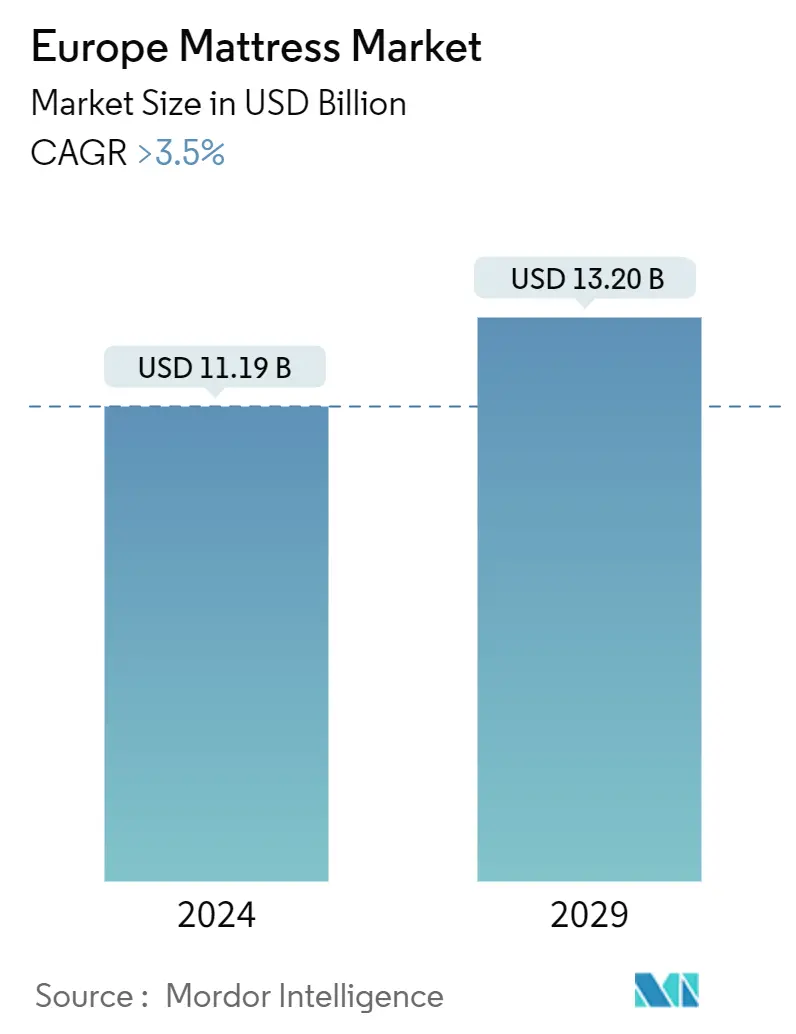Market Size of Europe Mattress Industry

| Study Period | 2020 - 2029 |
| Base Year For Estimation | 2023 |
| Market Size (2024) | USD 11.19 Billion |
| Market Size (2029) | USD 13.20 Billion |
| CAGR (2024 - 2029) | 3.50 % |
| Market Concentration | Medium |
Major Players
*Disclaimer: Major Players sorted in no particular order |
Europe Mattress Market Analysis
The Europe Mattress Market size is estimated at USD 11.19 billion in 2024, and is expected to reach USD 13.20 billion by 2029, growing at a CAGR of greater than 3.5% during the forecast period (2024-2029).
The European mattress market shifted towards more technologically advanced and eco-friendly products. For example, memory foam and latex mattresses gained popularity due to their comfort and support. There's also a growing emphasis on sustainable materials and manufacturing processes. Modern mattresses mainly contain innerspring materials such as latex, elastic, or polyurethane foam. A mattress can also be filled with air, water, or natural materials.
During the initial stage of COVID-19, due to supply chain disruptions, the market experienced losses due to stoppages in manufacturing and distribution services. Later, due to lockdowns and the work-from-home culture, the demand for mattresses rose. Post-COVID, the market is experiencing gradual growth according to seasonal demand fluctuations.
In past decades, people bought cotton or coir and converted it into mattresses. After diversity, it changed by using rubber and latex. Like many markets, the mattress industry is influenced by the rise of e-commerce. Online mattress retailers gained prominence, making it easier for consumers to research and purchase mattresses. Traditional brick-and-mortar stores are still significant, but the competition from online retailers led to innovation in both sales channels.
In the healthcare industry, the demand for mattresses is rising in nursing homes, clinics, and hospitals. The major players in the mattress market in Europe launched convenient, multifunctional hospital beds characterized by height adjustment and electronic connectivity features. The sale of innerspring mattresses in Europe is calculated to be consistent during the forecast period, which contributes more than 50% of the market share.
Europe Mattress Industry Segmentation
Mattresses are the primary bedding component, either directly on a bed frame or as a standalone bed. Factors such as the mattress's initial craftsmanship, material composition, and even the sleepers' weight and preferred sleeping styles can significantly impact the bed's overall durability.
European Mattress Manufacturers Market is segmented by type (innerspring mattress, memory foam mattress, latex mattress, and others), end-user (residential and commercial), distribution channel (online and offline), and Geography (United Kingdom, Spain, Germany, Italy, France, and rest of Europe). The market size and forecasts are provided regarding value (USD) for all the above segments.
| By Type | |
| Innerspring | |
| Memory Foam | |
| Latex | |
| Others |
| By End User | |
| Residential | |
| Commercial |
| By Distribution Channel | |
| Online | |
| Offline |
| By Geography | |
| United Kingdom | |
| Spain | |
| Germany | |
| Italy | |
| France | |
| Rest of the Europe |
Europe Mattress Market Size Summary
The European mattress market is undergoing a transformation, with a notable shift towards technologically advanced and eco-friendly products. The popularity of memory foam and latex mattresses is rising due to their comfort and support features. The market is also seeing an increased focus on sustainable materials and manufacturing processes. The impact of COVID-19 was significant, initially causing supply chain disruptions and losses, but later leading to increased demand as more people worked from home. The market is now experiencing gradual growth, influenced by seasonal demand fluctuations. The rise of e-commerce has further changed the landscape, with online retailers gaining prominence and driving innovation in both online and traditional sales channels. The healthcare sector is also contributing to market growth, with increased demand for specialized mattresses in nursing homes, clinics, and hospitals.
Consumer disposable income plays a crucial role in the European mattress market, directly affecting purchasing power and spending on non-essential items like mattresses. A strong residential market, characterized by increased homeownership and renovations, typically drives demand for new mattresses. This demand is further fueled by a preference for premium and high-end mattresses, as consumers invest in quality and comfort for their homes. The competitive landscape is intense, with a mix of global players, regional manufacturers, and new entrants vying for market share. Product innovation, quality, brand recognition, and distribution channels are key competitive factors. Physical stores remain important, as many consumers prefer to try mattresses in person. The market offers growth opportunities, with established retailers and online brands like Emma, Idle Sleeps, and Saatva playing significant roles. Recent developments, such as the release of the Saatva RX mattress and the restructuring of Hilding Anders International AB, highlight the dynamic nature of the market.
Europe Mattress Market Size - Table of Contents
-
1. MARKET DYNAMICS AND INSIGHTS
-
1.1 Market Overview
-
1.2 Market Drivers
-
1.2.1 Health and Wellness Trends are Driving the Market
-
1.2.2 Rising Disposable Income is Driving the Market
-
-
1.3 Market Restraints
-
1.3.1 Market Saturation is Handering the Growth
-
1.3.2 Seasonal Nature of Sales is Challenging the Market
-
-
1.4 Market Opportunities
-
1.4.1 Online Sales is Providing Opportunities for the Market
-
1.4.2 Customization and Personalization
-
-
1.5 Value Chain / Supply Chain Analysis
-
1.6 Porter's Five Forces Analysis
-
1.6.1 Bargaining Power of Suppliers
-
1.6.2 Bargaining Power of Buyers/Consumers
-
1.6.3 Threat of New Entrants
-
1.6.4 Threat of Substitute Products
-
1.6.5 Intensity of Competitive Rivalry
-
-
1.7 Insights on Key Trends and Techonological Innovations in the Market
-
1.8 Impact of Covid 19 on the Industry
-
-
2. MARKET SEGMENTATION
-
2.1 By Type
-
2.1.1 Innerspring
-
2.1.2 Memory Foam
-
2.1.3 Latex
-
2.1.4 Others
-
-
2.2 By End User
-
2.2.1 Residential
-
2.2.2 Commercial
-
-
2.3 By Distribution Channel
-
2.3.1 Online
-
2.3.2 Offline
-
-
2.4 By Geography
-
2.4.1 United Kingdom
-
2.4.2 Spain
-
2.4.3 Germany
-
2.4.4 Italy
-
2.4.5 France
-
2.4.6 Rest of the Europe
-
-
Europe Mattress Market Size FAQs
How big is the Europe Mattress Market?
The Europe Mattress Market size is expected to reach USD 11.19 billion in 2024 and grow at a CAGR of greater than 3.5% to reach USD 13.20 billion by 2029.
What is the current Europe Mattress Market size?
In 2024, the Europe Mattress Market size is expected to reach USD 11.19 billion.

